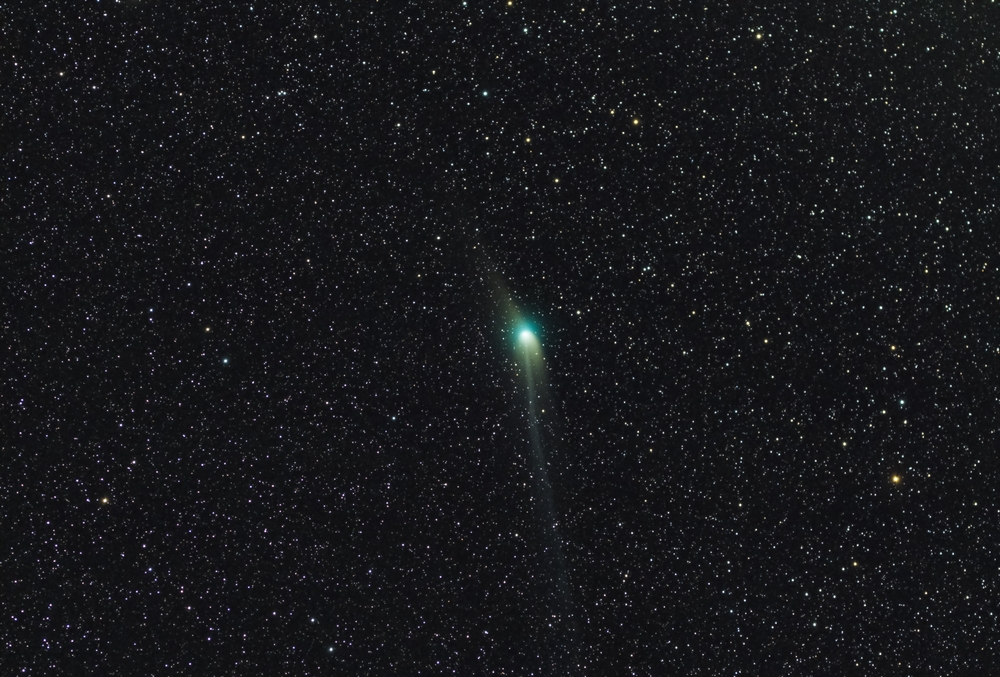The Oort Cloud Forms a Spiral at the Outskirts of Our Solar System
Posted on Categories Discover Magazine

At the edge of our solar system, a host of large, icy bodies make up the Oort cloud, which appears to sport two spiral arms reminiscent of a disk-shaped galaxy. New research founded upon a simulation using NASA’s Pleiades supercomputer has proposed that the Oort cloud takes on this spiral as a result of a phenomenon known as the Galactic tide, centered around gravitational forces.
A recent paper published in the arXiv preprint server presents an updated perspective on the Oort cloud, which has historically been understood only through scientists’ knowledge of distant comets. Although the Oort cloud hasn’t been directly observed, this latest simulation has allowed researchers to understand its existence better.
Creating Comets
The Oort cloud spans a great distance, from around 2,000 to between 100,000 and 200,000 astronomical units (au). For reference, 1 au is equivalent to nearly 150 million kilometers (93 million miles), and Neptune, the farthest planet in our solar system, is 30 au from the Sun.
The cloud is believed to appear as a shell of planetesimals — a small celestial body or planet — that surrounds the solar system. The identity of this presumed cloud is not fully known, but scientists strongly believe that it is a source of long-period comets (LPCs) that enter the inner solar system from time to time and can take upwards of 30 million years to orbit the Sun; these differ from short-period comets, which originate in the Kuiper Belt — a region of small bodies past Neptune but before the Oort cloud — and take less than 200 years to orbit the Sun.
LPCs are thought to travel mostly from the outer Oort cloud (which is past 10,000 au from the Sun), not the inner Oort cloud (between 2,000 and 5,000 au from the Sun). According to the study, bodies in the inner Oort cloud evolve too slowly and are ejected by planets before they can heat up and become active comets.
Read More: Astronomers Use JWST To Study a Rare Asteroid-Comet Hybrid Named “Chiron”
The Shaping of Spiral Arms
The researchers involved with the new study were interested in the inner Oort cloud for another reason: its shape. Pairing an analytic model with the supercomputer simulation, they concluded that the numerous bodies within the inner Oort cloud form a spiral structure that stretches about 15,000 au in length and is nearly perpendicular to the Galactic plane.
The researchers believe the spiral is likely a result of the Galactic tide, which describes the gravitational pull that comes from a variety of sources in the galaxy, such as stars and black holes.
While Earth and the other planets in the solar system are kept in their orbit due to the sun’s gravity, the orbit of objects within the Oort cloud is tilted by the Galactic tide. Gravitational forces have caused the icy bodies to gather into two spiral arms, making the inner Oort cloud look like a disk to a distant observer, the study states.
A Limited View
Direct observation of the inner Oort cloud remains difficult. Objects beyond Neptune that orbit the Sun, known as extreme trans-Neptunain objects (ETNOs), have been observed with telescopes before, such as the dwarf planet Sedna and 541132 Leleākūhonua. However, the researchers note that telescopic surveys aren’t yet advanced enough to detect objects of even more extreme orbits originating from the Oort cloud.
It seems that a clear picture of the Oort cloud won’t be possible for years. However, the discovery of its spiral shape is a promising step forward in understanding this region of space and its association with long-period comets that streak through the solar system.
Read More: An Asteroid Didn’t Kill Off the Dinosaurs — a Comet Did
Article Sources
Our writers at Discovermagazine.com use peer-reviewed studies and high-quality sources for our articles, and our editors review for scientific accuracy and editorial standards. Review the sources used below for this article:
Jack Knudson is an assistant editor at Discover with a strong interest in environmental science and history. Before joining Discover in 2023, he studied journalism at the Scripps College of Communication at Ohio University and previously interned at Recycling Today magazine.